Dr. Chiara Noli ECVD Dept.
Ear diseases represents a very common problem in Veterinary medicine, estimates
that up to 30% of dogs may have some otologic alteration. The underlying cause is
usually multifactorial, consisting of several components that, together, contribute
to the pathogenesis of disease. Allergic diseases such as food allergy or atopic
dermatitis often underlie otitis, less frequently endocrine, immune mediated or
other diseases.
Inflamed and oedematous duct skin due to allergy often encourages secondary,
bacterial and/or Malassezia. These contribute greatly to itching and
development of unpleasant smell. If the underlying cause (e.g., an allergy) or complicating infections are not properly managed, otitis can relapse or chronicize, leading to often frustrating management for owners and Veterinarians.
Since ear is coated by skin and is an organ well reached by topical therapy, in cases of external otitis therapy of choice is local. This can be based on either prescription drugs or free sales products, according to the cases. These need to be evaluated by otoscopic examination, before and after accurate cleaning of the duct, and by cytological examination of the exudate.
Scenario 1
Mild allergic otitis, erythema, open ear ducts, normal
cerumen
Erythematous otitis, usually itchy, without unpleasant smell, with excessive cerumen production and overgrowth of microorganism, is often indicative of a mild or early-stage allergy. In these animals it is advisable to start a strict hypoallergenic diet for 8 weeks with a commercial hydrolysate and starch-based food to identify a possible food allergy, and to treat the ducts with topical soothing, anti-inflammatory and anti-itching products. Among free sales products there are ear solution with chlorhexidine in combination with lactobionic acid, salicylic acid and glycerophosphoinositol lysine salt, which allow deep cleansing and moisturizing
of ear canal, reducing skin reactivity. These products are also able, if used on regular basis, to reduce recurrences of otitis in allergic animals 1.
In those cases where pruritus and inflammation are more severe, it has been reported the use of hydrocortisone acetate spray once a day until resolution of symptoms, then twice a week as maintenance 2.
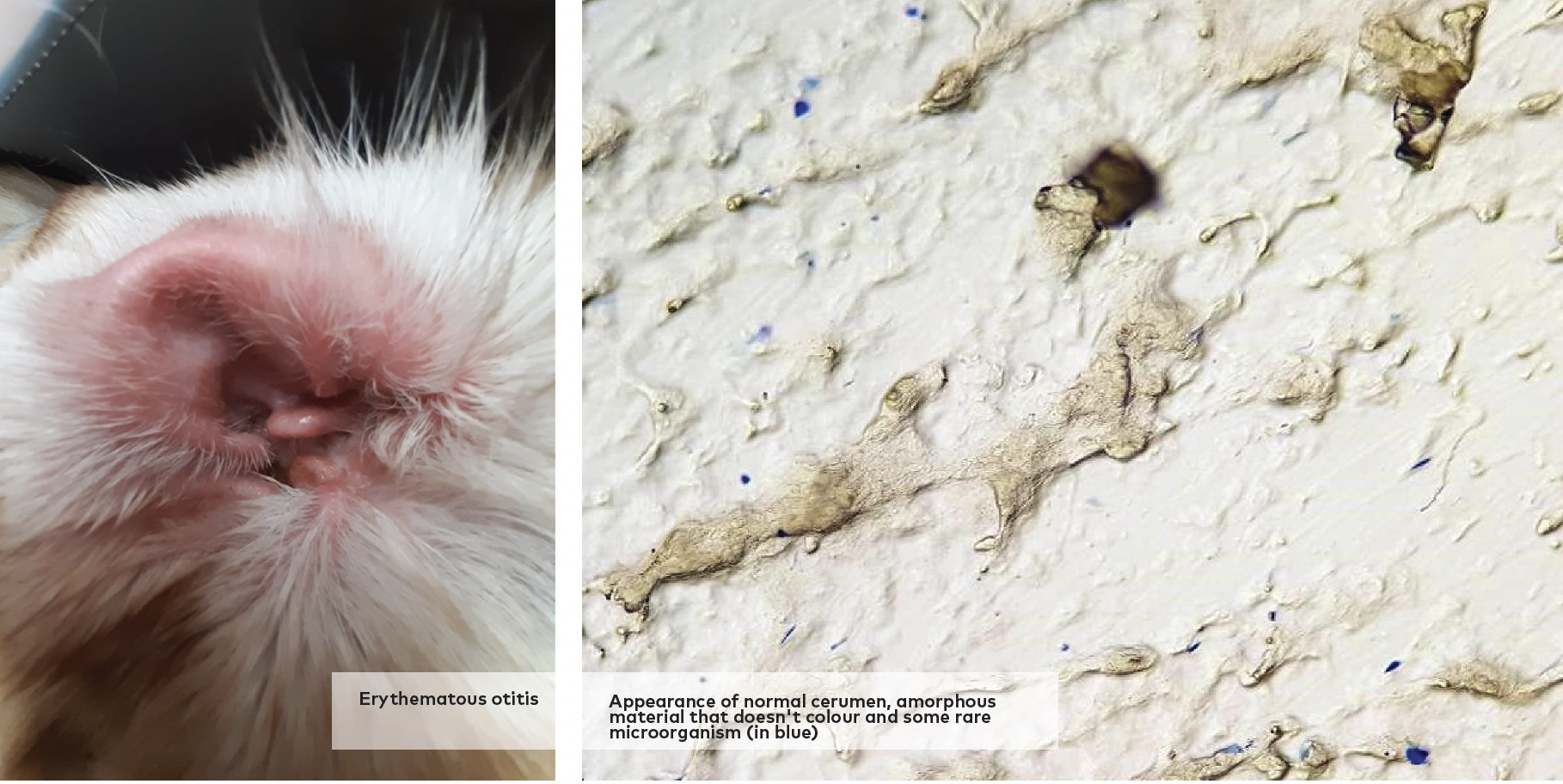
Scenario 2
Ceruminous otitis with excessive production of cerumen, absence of microorganisms on cytological examination
Ceruminous otitis with material filling the duct and obstructing the view of the eardrum is quite common and is an aggravation of the previous scenario. Therefore, this scenario can be observed in case of allergic diseases; however, it can also be associated with endocrine diseases (hypothyroidism) or keratinization disorders, such as idiopathic seborrhea of Cocker or in case of sebaceous adenitis. When on
cytologic examination no overgrowth of microorganisms is observed, all that needs to be done, beyond identifying and controlling where possible the underlying disease, is to clean the ducts on a regular basis with a ceruminolytic product.
Cleansing can initially be carried out by the Veterinarian under anaesthesia with highly effective foaming products, e.g., dioctyl sulfosuccinate and carbamide peroxide, after ascertaining tympanic integrity, taking care, however, to rinse well
the ducts after use because these products are irritating. In case you want to instill another product, it is advisable to wait at least 8h after the use of foaming products. On the other hand, if you want to leave a ceruminolytic in the hands of the owner, squalene-based products are effective and safe to apply daily for 2-4 weeks.
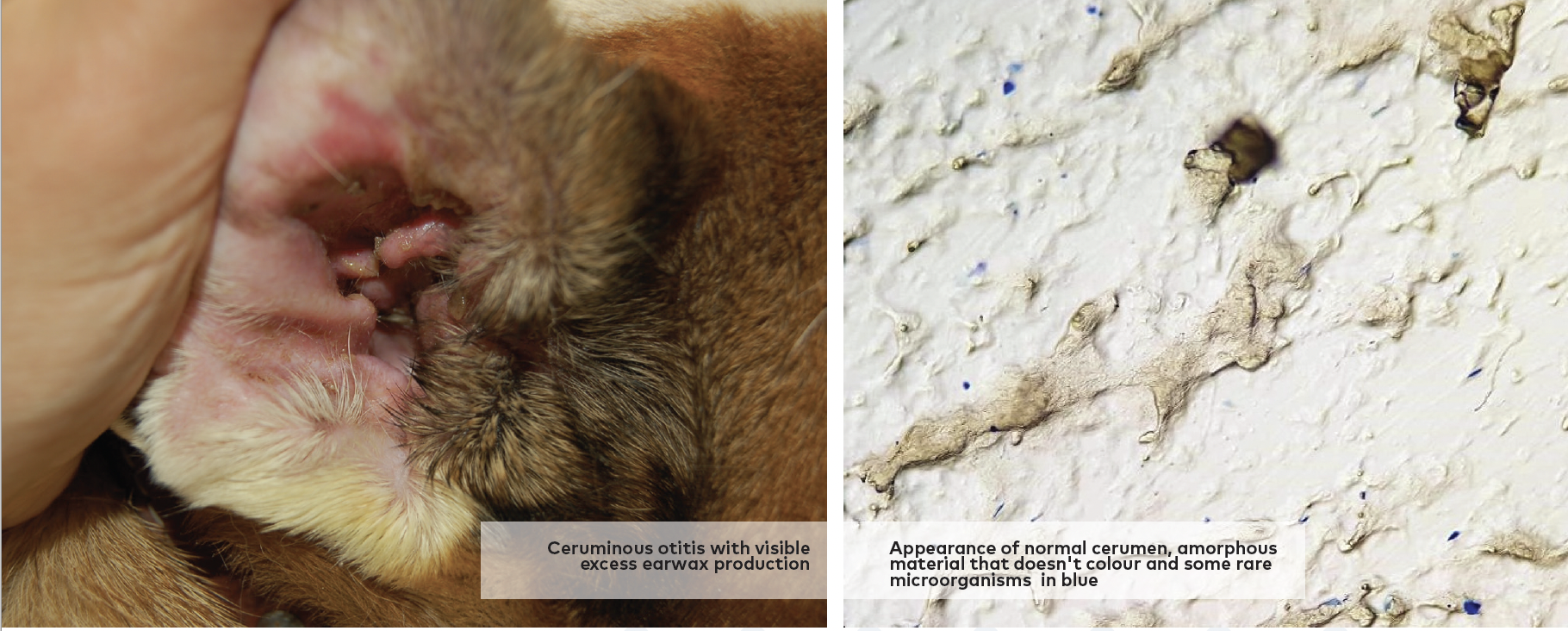
Scenario 3
Ceruminous otitis with unpleasant smell, overgrowth of cocci Bacteria and/or Malassezia
When otitis is complicated by microorganisms, such as cocci Bacteria and Malassezia, exceeding cerumen acquires a rancid smell, sometimes very unpleasant. The inflammation is often more severe, with very noticeable oedema, erythema and
itching.
If the overgrowth is not excessive, daily use of cleaning products containing disinfectants, e.g. chlorhexidine, whether or not combined with Tris-EDTA, can help. In an in vivo study on 11 dogs with bacterial, chronic external otitis, daily application
of a topical product containing chlorhexidine digluconate 0.15% + Tris-EDTA demonstrated a remarkable decrease in both clinical and cytological parameters (70%) in the first 14 days 3-5.
On the other hand, when the otitis is more severe, can persist for weeks or months, and the inflammation becomes chronic with evident oedema, stenosis of the duct, lichenification and hyperpigmentation of the pinna, then it may be useful to administer one or two weeks of systemic corticosteroids, such as prednisolone at 1 mg/kg, and instill a topical antibiotic and/or antifungal drug for one or two weeks.
An excellent alternative to the use of antibiotics is the administration of synthetic antimicrobial peptides in combination with low-dose chlorhexidine and Tris-EDTA 6.
In any case, since inflammation of the duct blocks the natural centrifugal migration of the epithelium from the eardrum to the tragus, which allows emptying and cleaning of the duct, it is always necessary to combine a daily flushing of the ducts
by the owner, at home, with disinfectant solution for at least a month, or until the “self-cleansing” process of the ducts resumes.
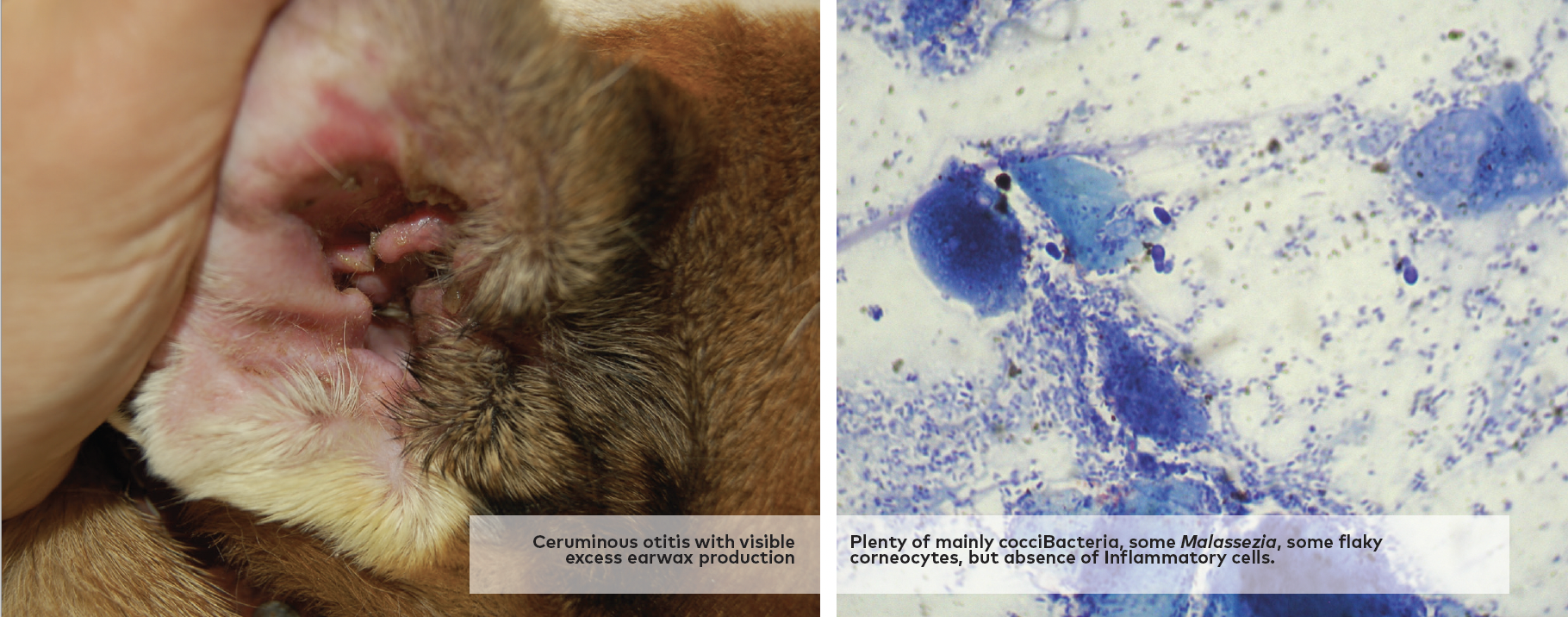
Scenario 4
Ceruminous or purulent otitis with presence of rod
bacteria
This scenario is similar to the previous one, with difference that Bacteria are not cocci, generally Staphylococci, but are rod. Generally, rod Bacteria are Gram -ve, such as Proteus, Escherichia coli, Corynebacterium o PseudomonasThese Bacteria have, compared with Gram+ve, a double membrane coated externally by lipopolysaccharides and proteins, more difficult to penetrate by antibiotics. In these cases, is helpful to use Tris-EDTA based products prior to apply topical antibiotics, as Tris-EDTA is able to weaken the membrane of Gram-ve bacteria and enhance
penetration and efficacy of antibiotics.
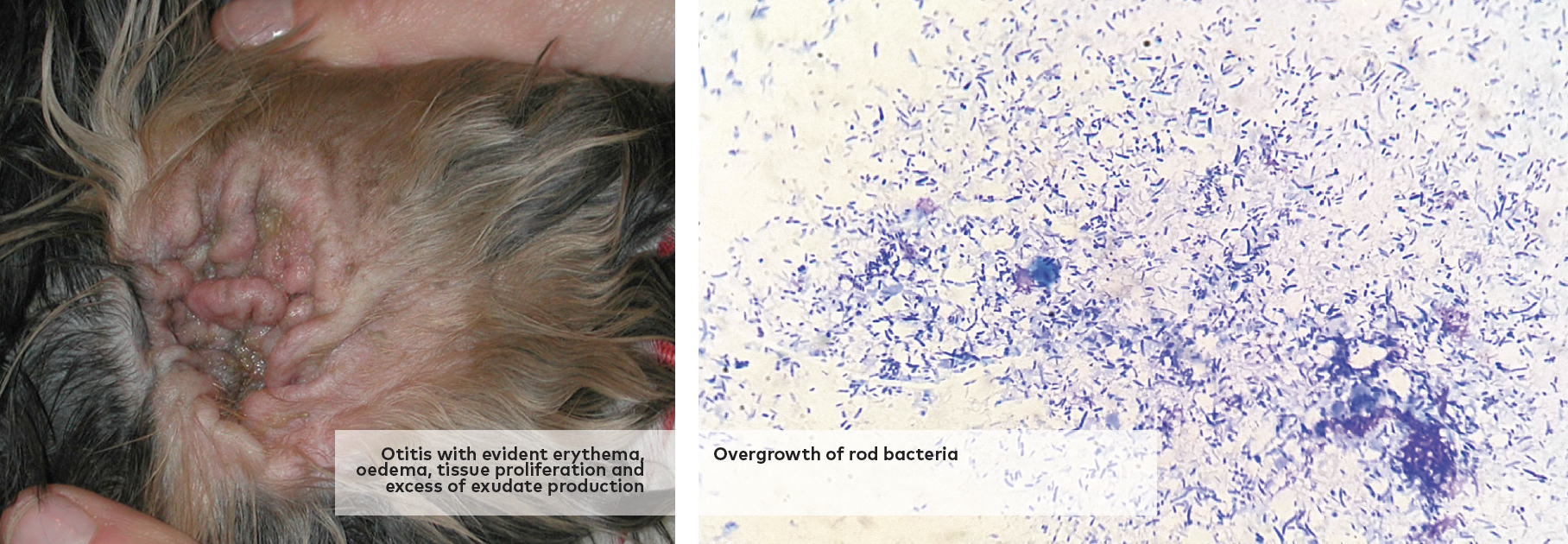
Scenario 5
Bacterial otitis and/or by Malassezia with biofilm
Sometimes otitis does not solve easily due to the fact bacterial strains or of Malassezia are biofilm producers. In fact bacteria can live in planktonic form (single cells), or become sessile, attached to a substrate, and start to produce multicellular colonies embedded with mucopolysaccharides with a mucous-like appearance, which protect them from external agents (drying, antibiotics) and from immune system attacks. In this condition, microorganisms are very difficult to kill and remove and are often responsible for otitis recalcitrant to common topical therapies. In these cases is more than useful, before common cleaning with a disinfectant and/or therapy with topic antibiotic or antimycotic, to do an ear flushing with products capable to disrupt biofilm such as those one with N-acetylcysteine combined with Tris-EDTA.
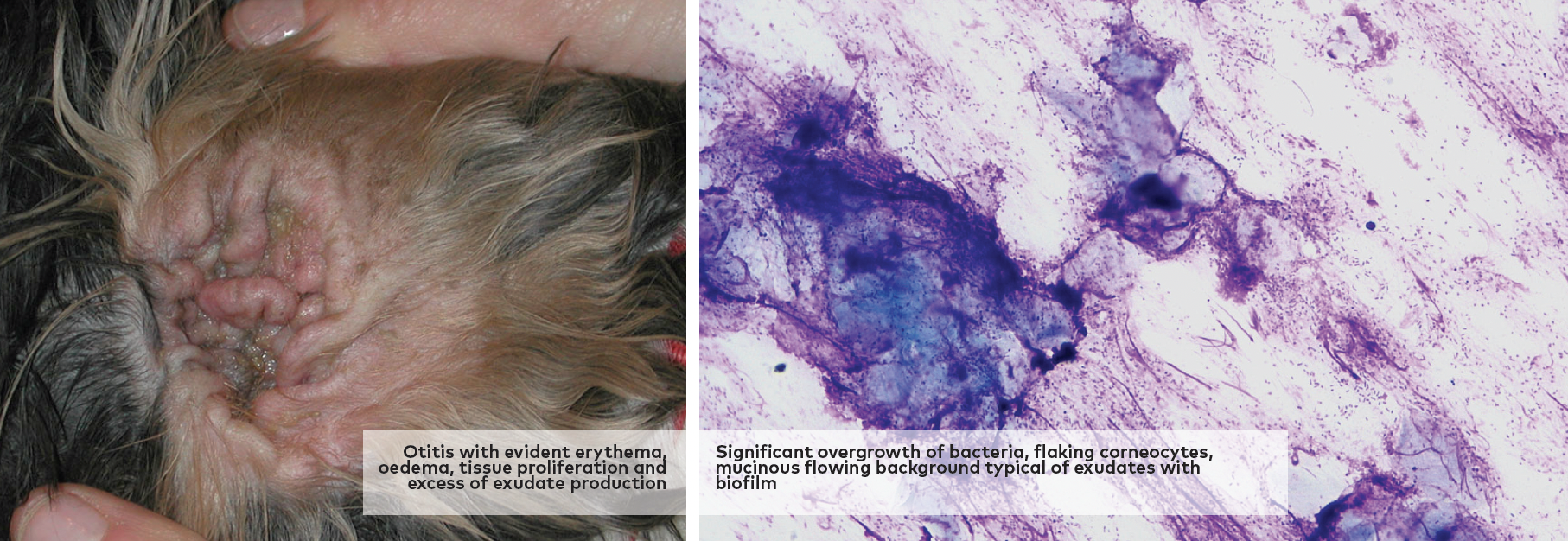
Scenario 6
Severe otitis with tympanic perforation
Otitis with tympanic perforation are mostly caused by Bacteria Pseudomonasand are associated with a foul smell, pus, ulcers and severe pain. In these cases, it is essential to give prednisolone at a dosage of 1-2mg/kg for one to two weeks, and systemic antibiotic for three to four weeks, chosen according to bacterial culture
and antibiogram. However, topical therapy, in combination with systemic one, is also very important, starting with a deep cleansing of the ducts performed under sedation by the Vet. As the eardrums are often perforated, it is necessary to use ear flushing products that are not ototoxic for middle and inner ear, such as disinfectants containing up to 0.2% chlorhexidine 7.
These products should then be continued with daily ear flushing for at least one month, followed by medicated otological drops, combined with above-mentioned systemic therapy.
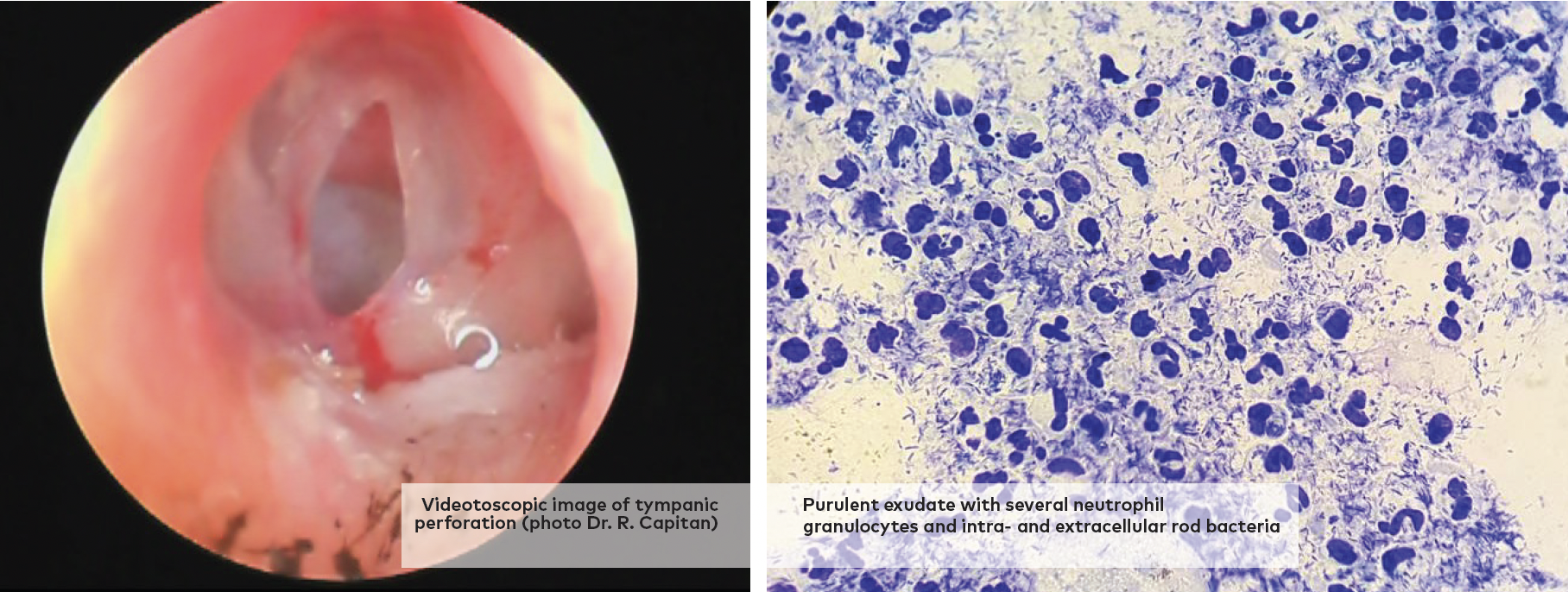
References
1. Ghibaudo G. Efficacy of Clorexiderm Oto in preventing bacterial otitis and bacterial overgrowth in allergy dogs (predisposed to chronic or recurrent otitis). Data on file, 2011
2. Bergvall K. Can topical hydrocortisone aceponate effectively control allergic otitis externa and reduce the risk of recurrence? Proceedings ESVD-ECVD Congress, lausanne, 2017, p.252.
3. Ghibaudo G. Cornegliani L. Martino P. Efficacy and tolerability of a solution with Tris-EDTA and chlorhexidine digluconate 0.15%. Summa 2007 (4), 1.
4. Ghibaudo G. Cornegliani L. Martino P. Evaluation of the in vivo effects of the Tris-EDTA and chlorhexidine digluconate 0.15% solution in chronic external bacterial otitis in dogs: 11 cases - Veterinary Dermatology 2004,
15(Suppl1):65
5. Noli C, Belova S, Bensignor B. et al. The use of an auricular cleansing solution based on chlorhexidine 0.15% and Tris-EDTA in bacterial otitis. Veterinaria 2012, 26(3): 39-45.
6. Ghibaudo G. Clinical study of the efficacy and tolerability of a new otological gel product containing AMP2041 (Peptivet® oto gel) in dogs with acute otitis externa. Comparison of two treatment protocols. Pet Summa. Number 2, March, attached, 2017
7. Merchant SR, Neer TM, Tedford BL, et al. Ototoxicity assessment of a chlorhexidine otic preparation in dogs. Prog Vet Neurol 1993
Otitis management
Dr. Chiara Noli ECVD Dept.
Ear diseases represents a very common problem in Veterinary medicine, estimates that up to 30% of dogs may have some otologic alteration. The underlying cause is usually multifactorial, consisting of several components that, together, contribute to the pathogenesis of disease. Allergic diseases such as food allergy or atopic dermatitis often underlie otitis, less frequently endocrine, immune mediated or other diseases.
Inflamed and oedematous duct skin due to allergy often encourages secondary, bacterial and/or Malassezia. These contribute greatly to itching and development of unpleasant smell. If the underlying cause (e.g., an allergy) or complicating infections are not properly managed, otitis can relapse or chronicize, leading to often frustrating management for owners and Veterinarians.
Since ear is coated by skin and is an organ well reached by topical therapy, in cases of external otitis therapy of choice is local. This can be based on either prescription drugs or free sales products, according to the cases. These need to be evaluated by otoscopic examination, before and after accurate cleaning of the duct, and by cytological examination of the exudate.
Scenario 1
Mild allergic otitis, erythema, open ear ducts, normal cerumen
Erythematous otitis, usually itchy, without unpleasant smell, with excessive cerumen production and overgrowth of microorganism, is often indicative of a mild or early-stage allergy. In these animals it is advisable to start a strict hypoallergenic diet for 8 weeks with a commercial hydrolysate and starch-based food to identify a possible food allergy, and to treat the ducts with topical soothing, anti-inflammatory and anti-itching products. Among free sales products there are ear solution with chlorhexidine in combination with lactobionic acid, salicylic acid and glycerophosphoinositol lysine salt, which allow deep cleansing and moisturizing of ear canal, reducing skin reactivity. These products are also able, if used on regular basis, to reduce recurrences of otitis in allergic animals 1.
In those cases where pruritus and inflammation are more severe, it has been reported the use of hydrocortisone acetate spray once a day until resolution of symptoms, then twice a week as maintenance 2.
Scenario 2
Ceruminous otitis with excessive production of cerumen, absence of microorganisms on cytological examination
Ceruminous otitis with material filling the duct and obstructing the view of the eardrum is quite common and is an aggravation of the previous scenario. Therefore, this scenario can be observed in case of allergic diseases; however, it can also be associated with endocrine diseases (hypothyroidism) or keratinization disorders, such as idiopathic seborrhea of Cocker or in case of sebaceous adenitis. When on cytologic examination no overgrowth of microorganisms is observed, all that needs to be done, beyond identifying and controlling where possible the underlying disease, is to clean the ducts on a regular basis with a ceruminolytic product.
Cleansing can initially be carried out by the Veterinarian under anaesthesia with highly effective foaming products, e.g., dioctyl sulfosuccinate and carbamide peroxide, after ascertaining tympanic integrity, taking care, however, to rinse well the ducts after use because these products are irritating. In case you want to instill another product, it is advisable to wait at least 8h after the use of foaming products. On the other hand, if you want to leave a ceruminolytic in the hands of the owner, squalene-based products are effective and safe to apply daily for 2-4 weeks.
Scenario 3
Ceruminous otitis with unpleasant smell, overgrowth of cocci Bacteria and/or Malassezia
When otitis is complicated by microorganisms, such as cocci Bacteria and Malassezia, exceeding cerumen acquires a rancid smell, sometimes very unpleasant. The inflammation is often more severe, with very noticeable oedema, erythema and itching.
If the overgrowth is not excessive, daily use of cleaning products containing disinfectants, e.g. chlorhexidine, whether or not combined with Tris-EDTA, can help. In an in vivo study on 11 dogs with bacterial, chronic external otitis, daily application of a topical product containing chlorhexidine digluconate 0.15% + Tris-EDTA demonstrated a remarkable decrease in both clinical and cytological parameters (70%) in the first 14 days 3-5.
On the other hand, when the otitis is more severe, can persist for weeks or months, and the inflammation becomes chronic with evident oedema, stenosis of the duct, lichenification and hyperpigmentation of the pinna, then it may be useful to administer one or two weeks of systemic corticosteroids, such as prednisolone at 1 mg/kg, and instill a topical antibiotic and/or antifungal drug for one or two weeks.
An excellent alternative to the use of antibiotics is the administration of synthetic antimicrobial peptides in combination with low-dose chlorhexidine and Tris-EDTA 6.
In any case, since inflammation of the duct blocks the natural centrifugal migration of the epithelium from the eardrum to the tragus, which allows emptying and cleaning of the duct, it is always necessary to combine a daily flushing of the ducts by the owner, at home, with disinfectant solution for at least a month, or until the “self-cleansing” process of the ducts resumes.
Scenario 4
Ceruminous or purulent otitis with presence of rod bacteria
This scenario is similar to the previous one, with difference that Bacteria are not cocci, generally Staphylococci, but are rod. Generally, rod Bacteria are Gram -ve, such as Proteus, Escherichia coli, Corynebacterium o PseudomonasThese Bacteria have, compared with Gram+ve, a double membrane coated externally by lipopolysaccharides and proteins, more difficult to penetrate by antibiotics. In these cases, is helpful to use Tris-EDTA based products prior to apply topical antibiotics, as Tris-EDTA is able to weaken the membrane of Gram-ve bacteria and enhance penetration and efficacy of antibiotics.
Scenario 5
Bacterial otitis and/or by Malassezia with biofilm
Sometimes otitis does not solve easily due to the fact bacterial strains or of Malassezia are biofilm producers. In fact bacteria can live in planktonic form (single cells), or become sessile, attached to a substrate, and start to produce multicellular colonies embedded with mucopolysaccharides with a mucous-like appearance, which protect them from external agents (drying, antibiotics) and from immune system attacks. In this condition, microorganisms are very difficult to kill and remove and are often responsible for otitis recalcitrant to common topical therapies. In these cases is more than useful, before common cleaning with a disinfectant and/or therapy with topic antibiotic or antimycotic, to do an ear flushing with products capable to disrupt biofilm such as those one with N-acetylcysteine combined with Tris-EDTA.
Scenario 6
Severe otitis with tympanic perforation
Otitis with tympanic perforation are mostly caused by Bacteria Pseudomonasand are associated with a foul smell, pus, ulcers and severe pain. In these cases, it is essential to give prednisolone at a dosage of 1-2mg/kg for one to two weeks, and systemic antibiotic for three to four weeks, chosen according to bacterial culture and antibiogram. However, topical therapy, in combination with systemic one, is also very important, starting with a deep cleansing of the ducts performed under sedation by the Vet. As the eardrums are often perforated, it is necessary to use ear flushing products that are not ototoxic for middle and inner ear, such as disinfectants containing up to 0.2% chlorhexidine 7.
These products should then be continued with daily ear flushing for at least one month, followed by medicated otological drops, combined with above-mentioned systemic therapy.
References
1. Ghibaudo G. Efficacy of Clorexiderm Oto in preventing bacterial otitis and bacterial overgrowth in allergy dogs (predisposed to chronic or recurrent otitis). Data on file, 2011
2. Bergvall K. Can topical hydrocortisone aceponate effectively control allergic otitis externa and reduce the risk of recurrence? Proceedings ESVD-ECVD Congress, lausanne, 2017, p.252.
3. Ghibaudo G. Cornegliani L. Martino P. Efficacy and tolerability of a solution with Tris-EDTA and chlorhexidine digluconate 0.15%. Summa 2007 (4), 1.
4. Ghibaudo G. Cornegliani L. Martino P. Evaluation of the in vivo effects of the Tris-EDTA and chlorhexidine digluconate 0.15% solution in chronic external bacterial otitis in dogs: 11 cases - Veterinary Dermatology 2004,
15(Suppl1):65
5. Noli C, Belova S, Bensignor B. et al. The use of an auricular cleansing solution based on chlorhexidine 0.15% and Tris-EDTA in bacterial otitis. Veterinaria 2012, 26(3): 39-45.
6. Ghibaudo G. Clinical study of the efficacy and tolerability of a new otological gel product containing AMP2041 (Peptivet® oto gel) in dogs with acute otitis externa. Comparison of two treatment protocols. Pet Summa. Number 2, March, attached, 2017
7. Merchant SR, Neer TM, Tedford BL, et al. Ototoxicity assessment of a chlorhexidine otic preparation in dogs. Prog Vet Neurol 1993
Related contents: